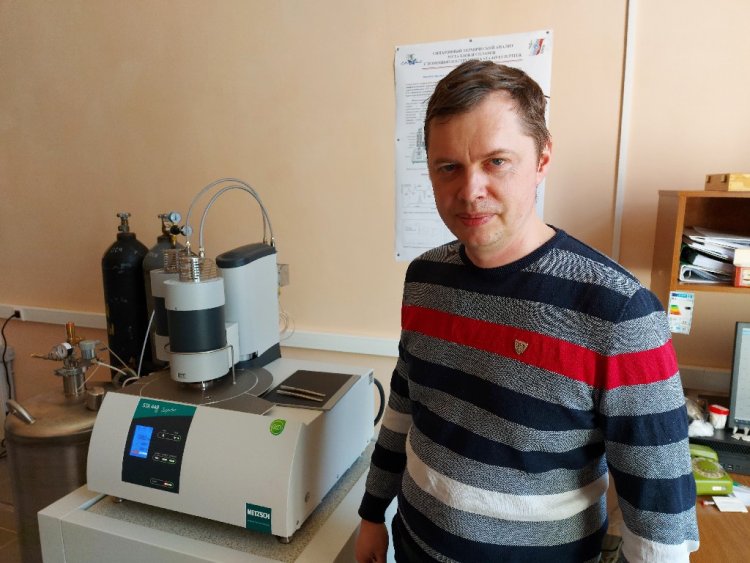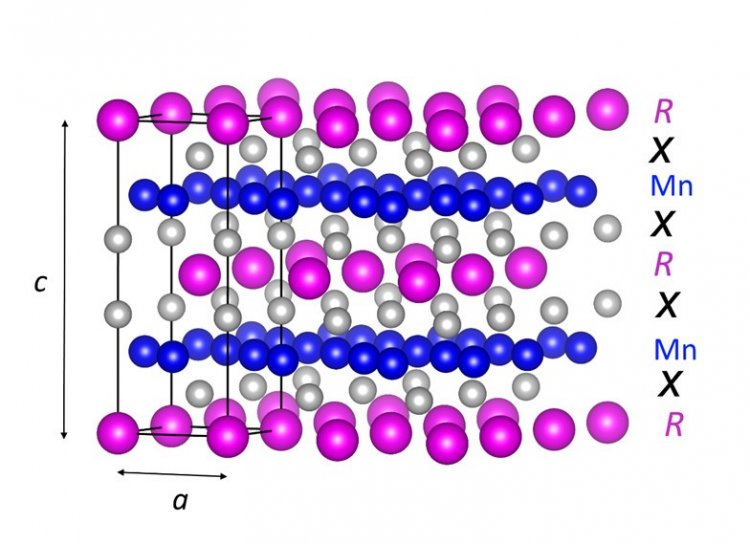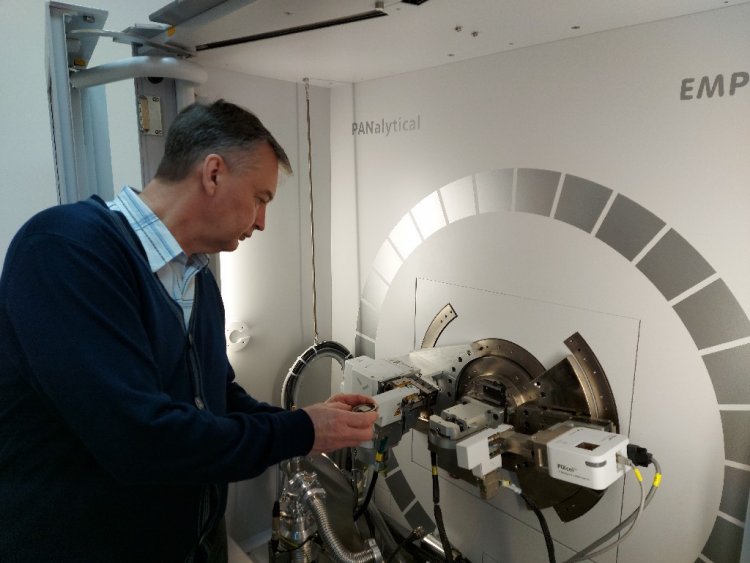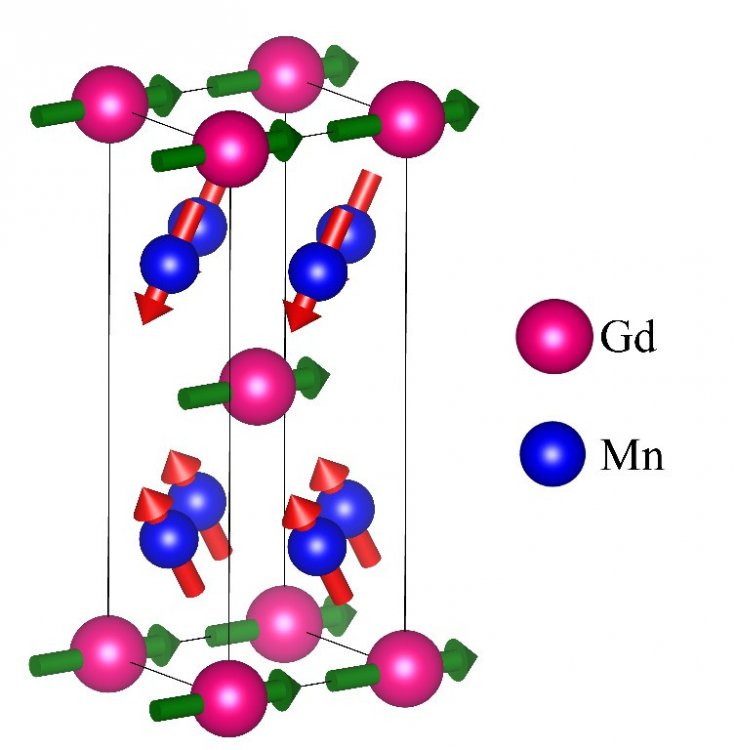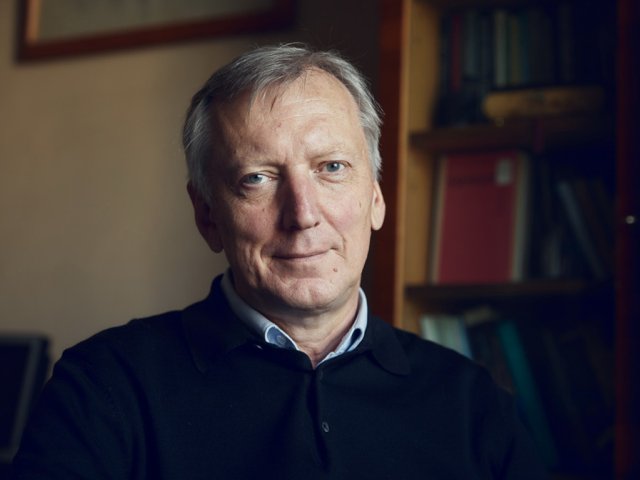The physicists from the Yekaterinburg-based Metal Physics Institute (MPI) of the Ural Subdivision of RAS in cooperation with foreign colleagues study the reasons behind the formation of structure and magnetic properties, magnetic anisotropy in particular, in monoatomic multilayer systems based on triple intermetallic compounds. It is a step forward in research of fundamental properties in solid state physics. As for practical application, it can be used in creation of functional nanomaterials with given properties.
Intermetallic compounds of rare-earth elements with layered crystal structure are promising materials for many practical application areas and unique modeling objects for fundamental research in condensed matter physics.
The project developed by employees of the Mikheyev Metal Physics Institute (Yekaterinburg) – "Light-axis-type anisotropy in layered compound GdMn2Si2 with magnetic crystal anisotropy of light-axis type – implemented under the state assignment of the Russian Education and Science Ministry (code Magnet, No.АААА-А18-118020290129-5)" is aimed at studying the reasons behind the formation of magnetic anisotropy of light-axis type and identification of magnetic structure in GdMn2Si2. compound.
The research (project term – from 2019 to 2020) was carried out in cooperation with foreign colleagues from Institute Laue-Langevin (Grenoble, France) and Helmholtz-Zentrum Dresden-Rossendorf (Dresden, Germany).
The measurement of magnetization curves using monocrystalline samples of GdMn2Si2, experimental monitoring of the impact produced by external magnetic field on magnetic phase transitions and neutron diffraction research confirmed the theoretical model of scientists describing magnetism and provided direct evidence as to the existence of predicted magnetic structures.
Pavel Terentyev, candidate of physics and mathematics, senior research fellow at the laboratory of ferromagnetic alloys, head of the sector for pulsed magnetic fields at the Testing Center of Nanotechnologies and Promising Materials, Laboratory of Electric Phenomena, Mikheyev Metal Physics Institute of the Ural Subdivision of RAS.
The photo shows DSC calorimeter at the Testing Center.
Participants to the project – Pavel Borisovich Terentyev, candidate of physics and mathematics, senior research fellow at the laboratory of ferromagnetic alloys, head of the sector for pulsed magnetic fields at the Testing Center of Nanotechnologies and Promising Materials, Laboratory of Electric Phenomena, and Yevgeny Germanovich Gerasimov, candidate of physics and mathematics, leading research fellow, head of laboratory for promising magnetic materials, shared the success achieved and highlighted the reasons behind and process of the change in magnetic anisotropy type in layered intermetallic compounds based on rare-earth elements.
“One of the relevant areas of research in the physics of condensed state of matter and magnetic phenomena deal with studying the fundamental properties of nanoscale and multilayer film materials. There are three main reasons behind it. First, it is the need for further miniaturization of various electronic devices. Second, it is the continuous rise in technological level that allows for creating increasingly more advanced 2- and 3-dimensional objects increasingly smaller in size. Finally, the third one lies in numerous theoretical research projects predicting the unique physical properties of two-dimensional and quasi-two-dimensional systems.
However, there already are some intermetallic compounds with natural perfect layered crystalline structure with atoms of the same type forming monoatomic layers alternating in strict sequence. The group of such compounds includes intermetallic ones of RM2X2 type (R-rare earth metal, Y, Lu, Ca, Sr, Ba, Tl, Th or U; М – 3d (from Cr to Cu), 4d (from Ru to Ag) or 5d (from Re to Au) transition metal; X – Si or Ge). Limited number of chemical elements can form compounds with stoichiometry 1-2-2 and structure of ThCr2Si2 type in case of X = P, As, Sb, Sn, Se as well. The compounds crystallize in tetragonal crystal lattice of ThCr2Si2 type with atom layers of the same class alternating in strict sequence -R-X-M-X-R-X-M-X-R- along the tetragonal s-axis (see Fig. 1)
Figure 1. Perfect multilayer crystalline structure of RMn2X2 compounds with the structure of ThCr2Si2 type
Such compounds are unique macroscopic modeling objects for studying the mechanisms of forming physical properties in multilayered quasi-two-dimensional systems. The research of fundamental properties such compounds have allows for obtaining experimental data required for both development of fundamental insight into magnetic structures and phase transitions, and purposeful creation of functional nanomaterials with given properties representing artificial multilayered monoatomic structures.
Our research is aimed at identifying the impact of various factors upon the formation of magnetic properties, magnetic and electronic structure of perfect monoatomic multilayered systems based on triple intermetallic compounds RM2X2 with structure of ThCr2Si2 type,” Pavel Terentyev described in detail what makes layered compounds interesting for scientists.
What are the specifics of compounds with structure of ThCr2Si2 type?
“A very important special feature of RM2X2 compounds lies in the availability of atomic layers from different groups of the periodic table, which results in extremely wide range of physical phenomena observed in them, including superconductivity, heavy fermions, mixed valence of rare-earth ions, effects of crystal field, as well as various magnetic phase transitions and structures. Despite the abundance of experimental data, the nature of compounds’ magnetic behavior remains unclear and continues to be the object of intensive research. For instance, if we take all transition metals of ferrous group, only manganese and chromium possess non-zero magnetic moments. Iron and cobalt are non-magnetic in these compounds. RM2X2 compounds with M=Mn demonstrate extremely broad variety of magnetic structures and very uncommon correlation between the type of interlayer magnetic ordering as to the magnetic moments of manganese atoms and in-layer Mn-Mn interatomic distances. The value and sign of interlayer exchange interaction between the magnetic moments of manganese atoms located in neighboring layers depend heavily upon the distance between the neighboring manganese atoms in layer and actually do not depend on the interlayer distance. For compounds of RM2X2 type, there is a certain critical distance dc between the two neighboring manganese atoms in layer, which amounts to the value of about 0.286 nanometers. In compounds with distance between manganese atoms in layer dMn–Mn < dc, magnetic moments of manganese atoms located in neighboring layers feature antiferromagnetic ordering, while, as far as dMn-Mn > dc is concerned, they are ferromagnetic with predominant orientation of resulting magnetic moments of the layer being along the tetragonal axis in both cases. The dependence of inter-planar exchange interaction value upon the distance between Mn atoms in layer is so heavy that the alloys with dMn-Mn close to dc the phase transition from ferromagnetic to antiferromagnetic inter-planar ordering may be initiated by changes in temperature of crystal lattice parameters,” Yevgeny Gersimov offered the exhaustive explanation.
Yevgeny Germanovich Gerasimov, candidate of physics and mathematics, leading research fellow, head of laboratory for promising magnetic materials at the Mikheyev Metal Physics Institute of the Ural Subdivision of RA
What is meant under terms anisotropy of light-axis type and anisotropy of light-plane type?
“Anisotropy of light-axis type in RM2X2 compounds means that the magnetic moments of atoms in the absence of magnetic field are directed along the tetragonal s-axis, perpendicular to atomic planes. As for anisotropy of light-plane type, it means that magnetic moments of atoms are located within the boundaries of atomic planes,” Pavel Terentyev answered.
Why was GdMn2Si2 compound chosen as the object of research? What makes the change of magnetic anisotropy type from light-axis into light-plane one uncommon?
“While having studied the magnetic properties of La1-xGdxMn2Si2 compounds before (JOURNAL OF ALLOYS AND COMPOUNDS 769 (2018) 1096 https://doi.org/10.1016/j.jallcom.2018.08.068), we have discovered a peculiar change in magnetic anisotropy type with the growth of GD concentration. The magnetic anisotropy of compounds would change from anisotropy of light-axis type in LaMn2Si2 compounds to the one of light-plane type in La1-xGdxMn2Si2 compounds with Gd concentration of x ³ 0.4. The queerness of this change lies in the following. The magnetic anisotropy of intermetallic compounds based on rare-earth and 3d-transition metals is usually made up by way of adding anisotropy of rare-earth sub-lattice to 3d-tansition one. In case of La1-xGdxMn2Si2 compounds, it is made up of anisotropy of La-Gd sub-lattice and Mn one. Mn sub-lattice always demonstrates strong magnetic anisotropy of light-axis type. La-Gd sub-lattice should not possess magnetic anisotropy at all, as ions La and Gd feature zero orbital moment.
Therefore, La1-xGdxMn2Si2 compounds should demonstrate anisotropy of light-axis type at any concentration of x. Nevertheless, the growth in Gd concentration leads to the change in magnetic anisotropy of compounds.
In 2018, we assumed that the change of magnetic anisotropy type in La1-xGdxMn2Si2 compounds with Gd concentration of x ³ 0.4 occurred due to magnetic frustration in the layered structure of compounds and lead to formation of triangular magnetic structure in them. To confirm this assumption, we filed applications on a competition basis for projects on studying the magnetic structure of GdMn2Si2 compound using the unique neutron diffractometer in Grenoble (France) and making magnetic measurements in strong pulse magnetic fields at the European Laboratory of Strong Magnetic Fields in Dresden (Germany). The uniqueness of neutron diffractometer located in Grenoble (France) lies in the fact that it allows for seeing the magnetic structure with Gd which absorbs neutron heavily, so one cannot see it using conventional diffractometers, because the neutrons are absorbed instead of being dispersed,” the specialists from the Institute of Metal Physics (IFM) specified.
Figure 2. Magnetic structure of GdMn2Si2 compound at temperature Т = 10 K (JOURNAL OF ALLOYS AND COMPOUNDS 818 (2020) 152902
“The research that we carried out confirmed the existence of triangular magnetic structure and the factors causing anisotropy of light-plane type in La1-xGdxMn2Si2 compounds with Gd concentration of Gd x > 0.4. The measurements made in strong pulse magnetic fields allowed us to identify the exchange interaction constants and predict the behavior typical for the magnetic moments of compounds in still stronger magnetic fields.
It stands to mention that all co-authors of the scholar paper have made a substantial contribution to the accomplishment of this task: RAS academician Nikolay Varfolomeevich Mushnikov, leading research fellow Vasily Semenovich Gaviko, leading research fellow Andrey Fedorovich Gubkin (IMP), Denis Igorevich Gorbunov (HLD-EMFL), and Henry Fisher (ILL) (JOURNAL OF ALLOYS AND COMPOUNDS 818 (2020) 152902 https://doi.org/10.1016/j.jallcom.2019.152902),” Pavel Terentyev and Yevgeny Gerasimov stressed.
What theoretical models did you use for describing the magnetic properties of compounds?
“In case of GdMn2Si2 compound, we used the theoretical Jafet-Kittel model suggested before for describing the magnetic properties of multi-sub-lattice ferrites. The calculations were made with the help of numerical methods,” Pavel Terentyev said.
What further effects in layered compound do you plan to study?
“We expect to continue the research aimed at studying the magnetic frustrations in layered compounds. At present, the researchers are active in studying the frustration in systems with triangular crystal lattice of Kagome type. The frustrations in compounds with layered crystal structure that we have discovered extend the class of frustrated systems and may attract the interest in new theoretical and experimental research projects. Besides, the scientists all over the world have recently demonstrated increased interest in studying the abnormal Hall effect in layered compounds. We work in this area of research too,” employees of IMP Pavel Terentyev and Yevgeny Gerasimov shared their plans.
The new approaches to the problem of anisotropy developed by the specialist of IMP offer new data dealing with magnetic structure of intermetallic compounds. The relevance of studying the properties of layered compounds and effects taking place in them determines the scope of future research tasks.
All photos and pictures are provided by Pavel Terentyev and Yevgeny Gerasimov
